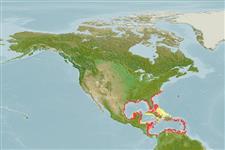>
Gobiiformes (Gobies) >
Microdesmidae (Wormfishes) > Microdesminae
Etymology: Microdesmus: Greek, mikros = small + Greek, desmos = link (Ref. 45335).
Environment: milieu / climate zone / depth range / distribution range
Ecologia
marinhas demersal; intervalo de profundidade 5 - 10 m (Ref. 10815). Subtropical; 37°N - 8°N, 98°W - 60°W
Western Atlantic: Bermuda, North Carolina (USA), and northern Gulf of Mexico to the Cayman Islands. Eastern Atlantic: only known from two specimens (one extant) from Joal, Senegal (Ref. 10815, 81289). This species’ appearance in brackish waters of West Africa is likely to be very rare, but cannot be discounted (Ref. 81289).
Tamanho / Peso / Idade
Maturity: Lm ? range ? - ? cm
Max length : 27.0 cm TL macho/indeterminado; (Ref. 7251)
Espinhos dorsais (total) : 19 - 23. Diagnosis: 62-80 (usually 66-75) total dorsal fin rays, including 19-23 spines; 36-52 (usually 40-47) total anal fin rays; anal fin usually originating between verticals from dorsal fin elements 25-31; caudal fin rounded (Ref. 81289).
Coloration: (based on description of juvenile pigmentation, by Smith&Thacker 2000): body tan, with melanophores scattered over flanks and dorsum, forming a stripe on dorsum and a thinner stripe on flanks; mottled pigmentation on head (Ref. 81289).
Known from muddy littoral and estuarine habitats (Ref. 81289). Burrows in shallow muddy and sandy bottoms (Ref. 7251). Postlarvae and early juveniles (to ca 2-2.5 cm SL) may occur in surface plankton to distances of 15 km or more offshore; subadults and adults occasionally found swimming near the surface at night (Ref. 10815).
Ciclo de vida ou comportamento de acasalamento
Maturities | Reprodução | Spawnings | Egg(s) | Fecundities | Larvas
Robins, C.R. and G.C. Ray, 1986. A field guide to Atlantic coast fishes of North America. Houghton Mifflin Company, Boston, U.S.A. 354 p. (Ref. 7251)
Status na Lista Vermelha da UICN (Ref. 130435)
Ameaça para os humanos
Harmless
Uso pelos humanos
Ferramentas
Relatórios especiais
Baixar XML
Fontes da internet
Estimates based on models
Preferred temperature (Ref.
123201): 23.3 - 28.3, mean 27.2 °C (based on 426 cells).
Índice de diversidade filogenética (Ref.
82804): PD
50 = 0.5000 [Uniqueness, from 0.5 = low to 2.0 = high].
Bayesian length-weight: a=0.00102 (0.00046 - 0.00225), b=3.06 (2.88 - 3.24), in cm total length, based on all LWR estimates for this body shape (Ref.
93245).
Nível Trófico (Ref.
69278): 3.9 ±0.5 se; based on size and trophs of closest relatives
Fishing Vulnerability (Ref.
59153): Low vulnerability (17 of 100).
